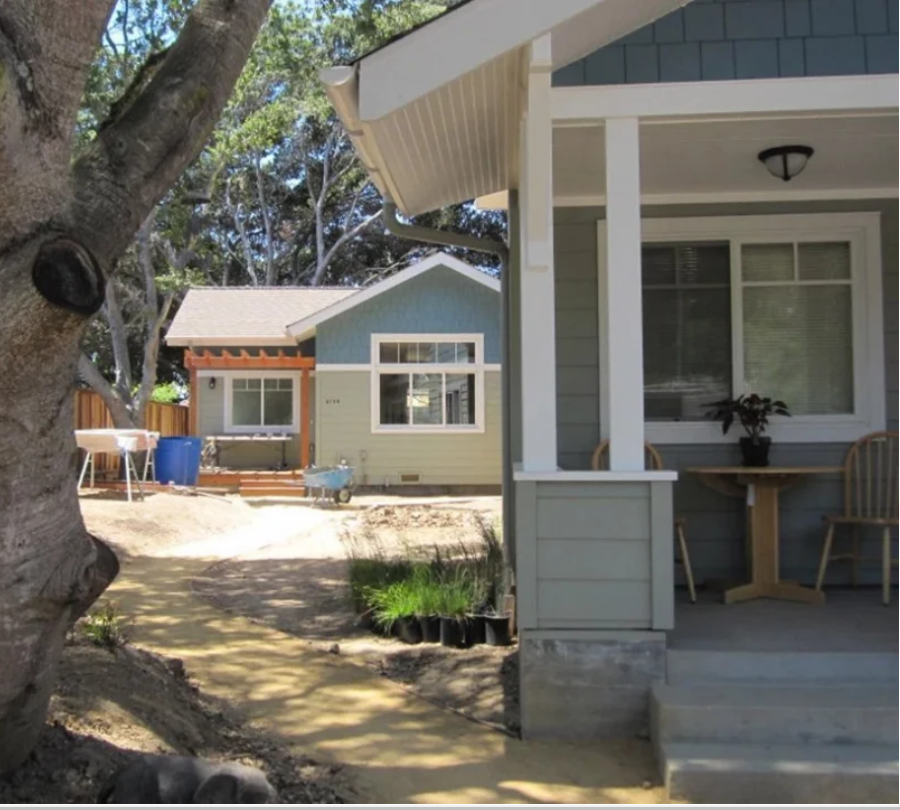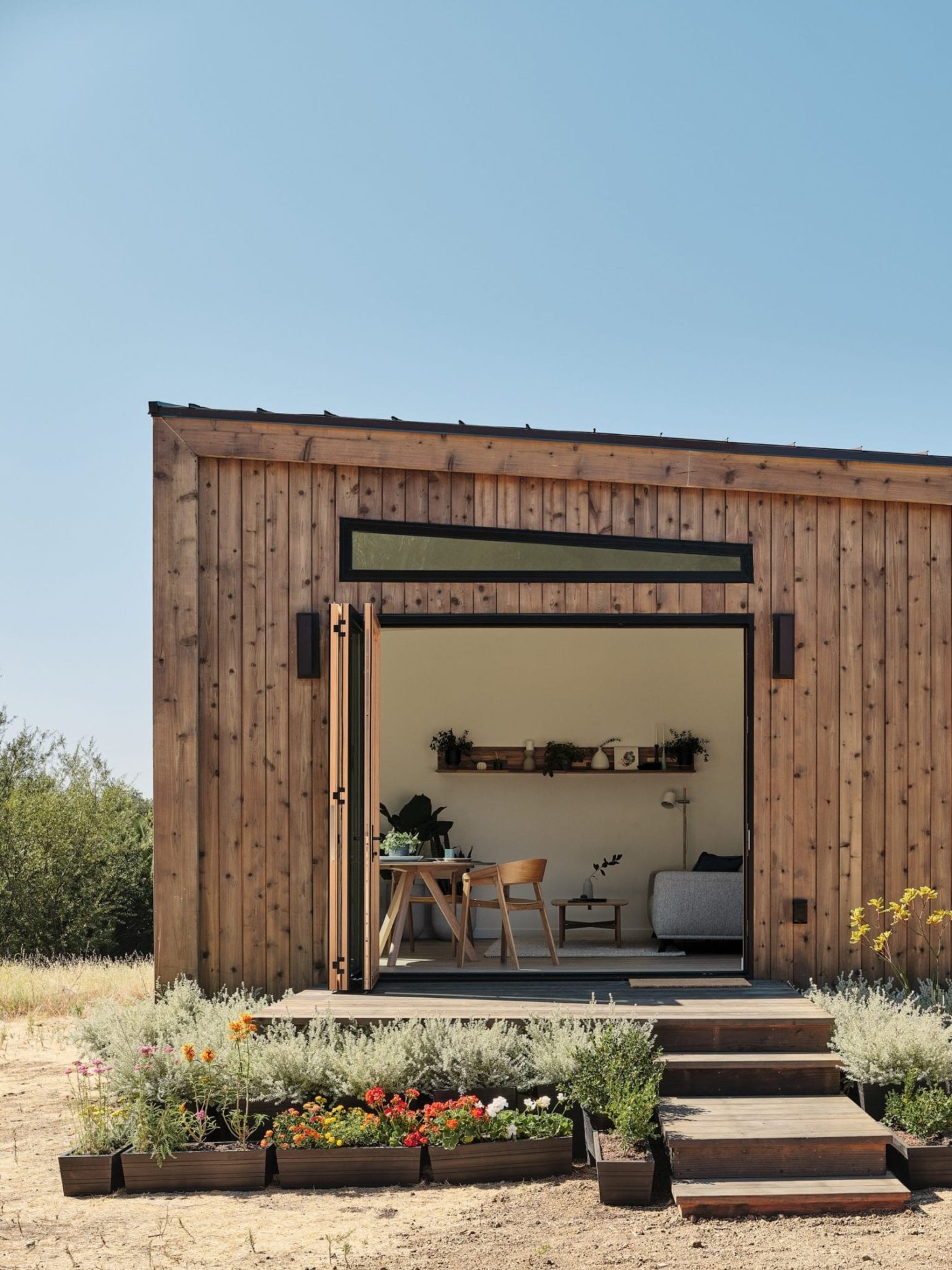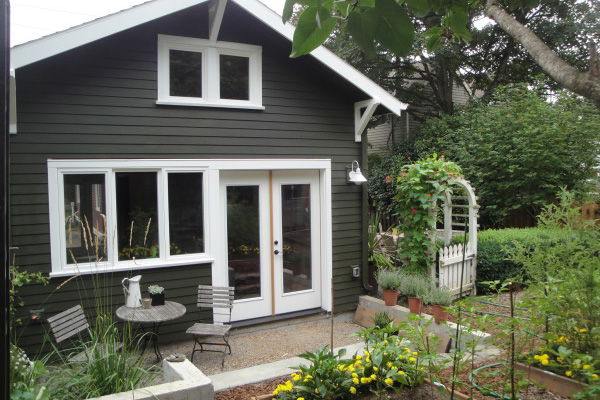
Accessory Dwelling Units (ADUs), sometimes called secondary units, granny units, in-law units, and backyard cottages, are self-contained residential units located on the same lot as, but separate from, the primary unit, with a separate entrance, kitchen, and bathroom. ADUs can be either attached or detached from the main dwelling, and are sited in a manner that preserves the single-family nature of a neighborhood. A junior ADU (JADU) is an ADU typically attached to or built within the footprint of the primary residence and does not include complete facilities (e.g., less than a complete kitchen).
When a homeowner adds an ADU to their property, they not only gain financial and lifestyle benefits, but they also help close the housing shortage in the United States with homes that typically rent at prices below the median. ADUs are a means of producing a meaningful amount of new housing units, by some estimates up to 1.8M in California alone.
Beyond increasing the supply of housing, ADUs provide benefits to homeowners. ADUs often house family members, allowing children to care for aging parents or grandparents to help with childcare. Other homeowners opt to rent out their ADU to earn supplemental income as renting an ADU can provide an outsized financial return to homeowners compared to other investments. Finally, ADUs can provide income diversification that can help homeowners remain housed during an income shock, such as a loss of employment. ADUs can provide homeowners lifestyle flexibility and can help them to increase financial stability, making them an especially powerful tool for low-income / wealth and BIPOC homeowners, the latter of which are at the highest risk of losing their homes in a short sale or foreclosure after purchase.
Financing for ADUs

ADUs, though less expensive than other forms of housing, require significant financial resources to construct—the median cost to build an ADU in California in 2018 was estimated at $150,000 while 13% of ADUs were estimated to cost more than $300,000 to build. Recent statewide legalization of ADUs has led to a rapid growth, but research has shown that ADUs are being built disproportionately in whiter and more affluent communities. For lower-income and lower-wealth individuals, ADU construction requires financing. For many of these homeowners, though, there is limited access to adequate financing to construct an ADU. A 2022 study from the Terner Center for Housing Innovation examines barriers to racial and economic equity in ADU construction and makes recommendations for how to help break them down.
The Housing Trust Silicon Valley has developed an ADU financing program, which provides free informational workshops to interested homeowners, and a loan program to encourage ADU production throughout Santa Clara County. The loan program covers detached ADUs and garage conversions, and requires that a homeowner agree to a 2-year affordability restriction: ADUs built with the loan must be rented to a low-to moderate-income household for at least two years. As financing can otherwise be a major hurdle, having a consistent resource in the region can assist many homeowners in reaching the finish line of their ADU projects. Learn more about the Housing Trust’s Small Homes, Big Impact program.
The California Housing Finance Authority’s (CalHFA) ADU Grant provides up to $40,000 to reimburse pre-development and non-reoccurring closing costs associated with the construction of the ADU for moderate- and low-income homeowners. Predevelopment costs include site prep, architectural designs, permits, soil tests, impact fees, property survey, and energy reports. Learn more about ways homeowners can finance ADU construction.
Recent ADU Laws Have Increased Production
By State law, ADUs are allowed in all cities in California. Recent changes to State law, established by a series of bills including SB 1069 (Wieckowski, 2016) and AB 2299 (Bloom, 2016) have required local jurisdictions to ease certain zoning regulations to support the creation of ADUs. Most cities in Santa Clara County updated their ordinances to comply with the new law.
Since the passage of these bills, the number of ADUs issued permits in Santa Clara County jurisdictions has been steadily increasing, as shown in the table below (with a slight decline from 2019 to 2020, during the COVID-19 pandemic).
| Jurisdiction | 2017 | 2018 | 2019 | 2020 | 2021 | 2022 | 2023 | 2024 | Total |
| Campbell | 3 | 3 | 9 | 17 | 39 | 53 | 48 | 70 | 242 |
| Cupertino | 11 | 13 | 15 | 19 | 41 | 30 | 17 | 44 | 190 |
| Gilroy | 7 | 7 | 11 | 13 | 27 | 16 | 40 | 38 | 159 |
| Los Altos | 4 | 8 | 36 | 23 | 62 | 62 | 219 | 62 | 476 |
| Los Altos Hills | 7 | 26 | 8 | 25 | 41 | 31 | 23 | 35 | 196 |
| Los Gatos | 4 | 43 | 28 | 28 | 36 | 35 | 41 | 26 | 241 |
| Milpitas | 9 | 4 | 17 | 24 | 32 | 71 | 33 | 44 | 234 |
| Monte Sereno | 12 | 9 | 14 | 9 | 14 | 18 | 13 | 9 | 98 |
| Morgan Hill | 18 | 15 | 3 | 15 | 13 | 23 | 27 | 9 | 123 |
| Mountain View | 4 | 15 | 18 | 17 | 31 | 42 | 70 | 57 | 254 |
| Palo Alto | 12 | 36 | 62 | 43 | 89 | 120 | 127 | 128 | 617 |
| San Jose | 92 | 187 | 416 | 331 | 420 | 448 | 470 | 558 | 2,922 |
| Santa Clara | 4 | 9 | 71 | 51 | 53 | 76 | 54 | 55 | 373 |
| Saratoga | 11 | 10 | 25 | 41 | 66 | 46 | 79 | 74 | 352 |
| Sunnyvale | 6 | 19 | 40 | 56 | 30 | 59 | 59 | 72 | 341 |
| Unincorporated County | 17 | 29 | 32 | 42 | 56 | 81 | 88 | 56 | 401 |
| Total | 221 | 433 | 805 | 754 | 1,050 | 1,211 | 1,408 | 1,337 | 7,219 |
SV@Home’s Position: We Need New and Innovative Housing Solutions
SV@Home is working to promote policies and implementation actions that increase the number of lots that could qualify for a second unit and that provide flexibility and simplicity for homeowners, including provision of technical assistance and support.
Our policy recommendations for second units focus on:
- Simplifying and easing development standards: reducing or eliminating minimum lot size requirements to increase the number of properties where second units can be built.
- Eliminating fees: removing fees decrease overall project costs, allowing more property owners to take advantage of simplified development standards
- Amnesty: enabling amnesty for units that were illegally built as long as they are brought up to current building codes.
Read more in our ADU White Paper
Additional Resources
- Terner Center for Housing Innovation: ADUs for All: Breaking Down Barriers to Racial and Economic Equity in Accessory Dwelling Unit Construction (2022)
- Terner Center for Housing Innovation & USC Lusk Center for Real Estate: ADU Construction Financing: Opportunities to Expand Access for Homeowners (2022)
- UC Berkeley’s Center for Community Innovation: Implementing the Backyard Revolution: Perspectives of California’s ADU Owners (2021)
- Home For All San Mateo County & 21 Elements: Second Unit Resource Center & Cost Calculator
- California Department of Housing and Community Development: Accessory Dwelling Units (ADUs) and Junior Accessory Dwelling Units (JADUs) (2022) & Accessory Dwelling Unit Handbook (2022)
- Terner Center for Housing Innovation: Reaching California’s ADU Potential: Progress to Date and the Need for ADU Finance (2020) & First Ever Statewide ADU Owner Survey Shows Growth, Room for Improvement (2021)
- Housing Trust Silicon Valley Small Homes, Big Impact: Highlights of 2019 ADU Workshop 2019
- AARP: The ABCs of ADUs 2019
- SV@Home ADU White Paper 2019
